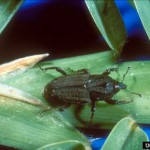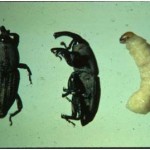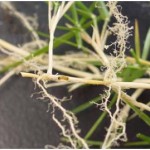An Emerging Pest of Texas Turfgrass
Populations of the hunting billbug (Sphenophorus venatus vestitus Chittenden) (Fig. 1) have increased over the past 10 to 15 years and this billbug is responsible for extensive turf damage in residential and commercial lawns, in sod production fields, on sports fields and on golf courses of both bermudagrass and zoysiagrass. It also feeds on other turfgrasses including St. Augustinegrass, centipedegrass, and bahiagrass.
Billbug damage is often misidentified as drought, dormancy, disease, white grubs, or another root-feeding insect. Only one generation per year was reported in northern Florida, Louisiana, and Arkansas, but it may have at least two or three overlapping generations per year in Florida and Texas.
Adults

Hunting billbug, adult. Photo courtesy of University of Georgia, Bugwood.org
Hunting billbugs are a species of weevil or snout beetle (Coleoptera: Curculionidae) and are often noticeable crawling along sidewalks in turfgrass areas. The adult feeds by notching the leaves of both zoysiagrass and bermudagrass. It then lays its eggs in a small feeding scar usually in the crown of the plant.
Immature Stages
Larvae or grubs are distinct from white grubs (June beetles or masked chafers in the Scarabeidae group of beetles) because they are legless and generally smaller in size. They pass through five growth stages or instars between molts. Early instars feed within the crown, rhizomes, and stolons (Fig. 2) before the later instars emerge and continue feeding on the whole root system.
Damage
Initial larval damage appears as small pockets of yellowing and dying grass, resembling dollar spot disease infections, which increase in size and later coalesce as the larvae continue feeding. Infested sod fields often cannot be harvested since many of the roots and rhizomes have been severed and the cut sod will not block or hold together for transport.
Management
Among zoysiagrass cultivars, leaf-firing of plant canopy is considered an above ground expression of root feeding damage by larvae. Cultivars of Z matrella appear to be more resistant to hunting billbug as a group than the Z. japonica cultivars which are susceptible. In research plots, ‘Diamond’ and ‘Zorro’ have exhibited significantly less leaf firing damage. In contrast, ‘Palisades’, ‘Meyer’, and ‘Crowne’ showed more (40% canopy damage). When root, shoot, and total plant dry weights were compared, Diamond, Zorro, ‘Cavalier’, and ‘Royal’ [all Z. matrella (L.) Merr.] sustained less dry weight reduction (<53%) than Palisades, Meyer, and ‘El Toro’ (all Z. japonica Steud.) with 76, 74, and 70% total dry weight reduction, respectively.
A number of insecticides are registered for treating hunting billbug in turfgrass, and have been added to the handout provided at Extension meetings for turfgrass pest management for 2011 (Texas Turfgrass Integrated Pest Management (IPM) – Insecticide Alternatives (Rev. March 2011). Products are registered for targeting adults or larvae, and are applied as either curative or preventive applications.
Modified from:
Reinert, J. and B. M. Drees. 2011. The hunting billbug: an emerging pest of Texas turfgrass. The Pallet, April 2011 issue, pages 6-10.


